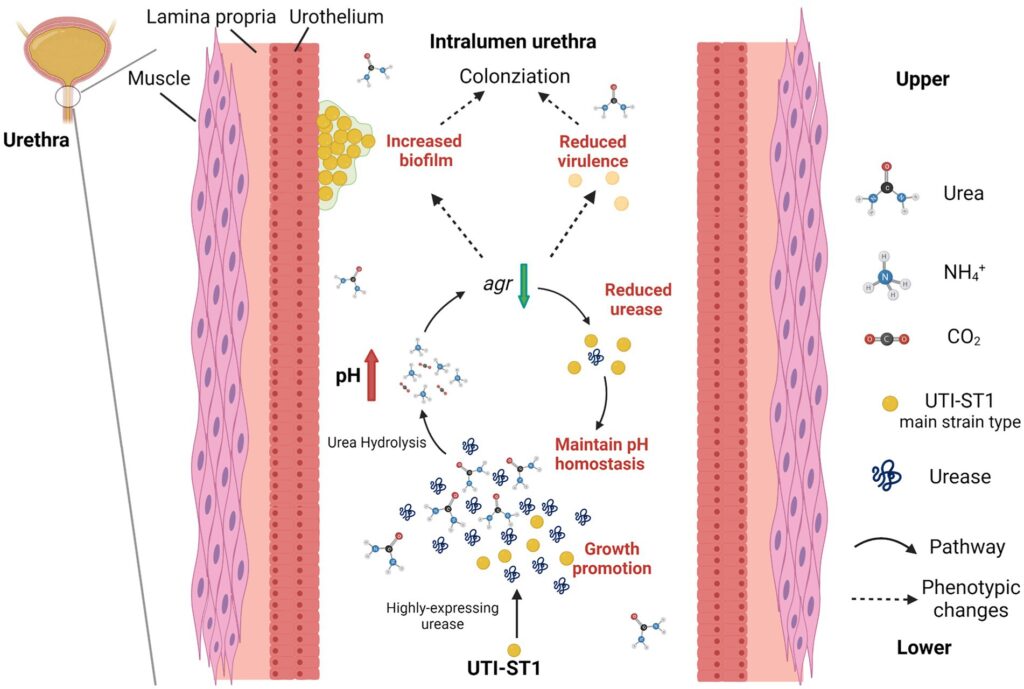Staphylococcus aureus is an uncommon but clinically significant cause of urinary tract infection (UTI). While Escherichia coli dominates community-acquired UTIs, S. aureus—particularly methicillin-resistant S. aureus (MRSA)—is increasingly detected in complicated and nosocomial urinary infections. Its presence in urine often signifies a more invasive process and warrants a thorough diagnostic and therapeutic approach.

Epidemiology and Risk Factors for S. aureus UTI
The incidence of S. aureus UTI varies by setting, with higher rates in hospitalized patients and those with indwelling catheters. Risk factors include:
- Urinary catheterization
- Urinary tract obstruction
- Diabetes mellitus
- Recent urological procedures
- Prolonged hospitalization
- Immunosuppression
- Hematogenous spread from distant infection
Pathophysiology: Routes of Urinary Tract Invasion
S. aureus can infect the urinary tract via two primary mechanisms:
- Hematogenous Route: Often from endocarditis, skin infections, or osteomyelitis
- Ascending Route: Less common, associated with urinary instrumentation or catheter use
Clinical Manifestations of Staphylococcus aureus UTI
Lower Urinary Tract Involvement (Cystitis)
- Dysuria
- Urgency
- Frequency
- Suprapubic discomfort
Upper Urinary Tract Involvement (Pyelonephritis)
- Flank pain
- Fever and chills
- Nausea and vomiting
- Costovertebral angle tenderness
Complications
- Bacteremia or urosepsis
- Renal abscesses
- Endocarditis in hematogenous cases
Microbiological Diagnosis and Evaluation
Urine Culture
- Quantitative threshold: >10⁵ CFU/mL of S. aureus typically significant
- Consider lower thresholds in symptomatic catheterized patients
Blood Culture
- Essential in febrile patients or those with suspected hematogenous dissemination
Imaging
- Ultrasound or CT scan to rule out obstruction or renal abscess in complicated cases
Additional Workup
- Echocardiography if bacteremia is present to exclude endocarditis
- Evaluate for primary infection sites in hematogenous spread
Antimicrobial Management of S. aureus UTI
Empirical Therapy Considerations
Empiric treatment should cover both gram-positive and gram-negative organisms in high-risk or hospitalized patients until culture results are available.
Targeted Antibiotic Therapy
| Pathogen Type | Oral Options | IV Options | Duration (Uncomplicated/Complicated) |
|---|---|---|---|
| MSSA | Cephalexin, Amoxicillin-Clavulanate | Cefazolin, Nafcillin | 7–14 days |
| MRSA | Linezolid, TMP-SMX | Vancomycin, Daptomycin, Linezolid | 10–14+ days depending on severity |
Antibiotic Penetration
Not all anti-staphylococcal agents achieve effective urinary concentrations. Selection must account for pharmacokinetics.
Indications for Hospitalization
- Systemic signs of infection (e.g., sepsis)
- Hemodynamic instability
- Inadequate outpatient support
- Renal impairment
- Pyelonephritis with complications
- Concomitant bacteremia
Prevention Strategies for Healthcare-Associated S. aureus UTI
Infection Control in Healthcare Settings
- Hand hygiene
- Aseptic catheter insertion techniques
- Early catheter removal
- Routine catheter care protocols
Antimicrobial Stewardship
- Avoid unnecessary antibiotic use to limit resistance development
- Tailor therapy based on culture and sensitivity data
MRSA Surveillance
- Screen high-risk patients
- Decolonization protocols in recurrent or outbreak settings
Prognosis and Follow-Up Recommendations
With early intervention and appropriate antimicrobial therapy, the prognosis for S. aureus UTI is favorable in most cases. However, delays in treatment or unrecognized bacteremia significantly worsen outcomes. Follow-up urine cultures are advised in:
- Persistent symptoms
- Recurrent UTIs
- Immunosuppressed patients
- Those with anatomical urinary tract abnormalities
Staphylococcus aureus urinary tract infections, while less common than those caused by gram-negative bacilli, present a serious clinical concern, particularly when associated with systemic involvement or healthcare interventions. Prompt diagnosis, guided antimicrobial therapy, and comprehensive evaluation of potential bacteremia are critical in managing these infections effectively. Preventive strategies targeting catheter-associated infections and antimicrobial resistance are vital components of long-term care and infection control.

